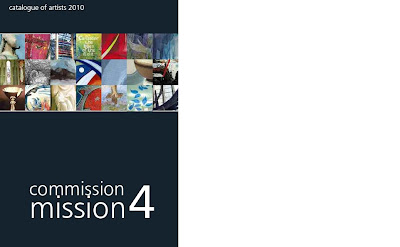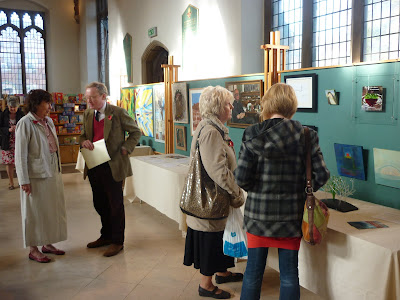What follows is the introduction by
Jonathan Evens to our
Study Day 'Perspectives on commissioning Christian Art' held on Saturday 7th November at
Chelmsford Cathedral. Summaries of the other presentations made at the Study Day and mentioned in this introduction will be included in subsequent posts:
commission4mission was launched in March 2009 by our Patron, the
Bishop of Barking, to encourage the commissioning and placing of contemporary Christian Art in churches as a means of fundraising for charities and a mission opportunity for churches.
We aim to:
• provide opportunities for churches to obtain and commission contemporary Christian Art for church buildings;
• provide information, ideas and examples of contemporary Christian Art and its use/display within church settings; and
• raise funds for charities through commissions and sales of contemporary Christian Art.
We promote the purchase of artworks by churches through donations given in memory of loved ones, with these people being commemorated in plaques placed (wherever possible) on or near the artwork itself.
Examples of the work of our artists, commissions to date, and exhibitions held can be seen on the screen. In the short time that commission4mission has been in existence we have:
• built up a pool of artists available for Church commissions and working in a wide range of media including: drawing, glass, jewellery, painting, photography, pottery, silver, and textiles (many of these artists are exhibiting in our showcase exhibition which can be viewed today);
• gained commissions for works at
Queens Hospital Romford and
St Pauls Goodmayes;
• organised six exhibitions including exhibiting at the
Pentecost,
West Ham and
Leytonstone Festivals and as part of the
E17 and
Leytonstone Art Trails;
• held a networking evening on the the theme of
'Spirituality - the heartbeat of Art?'• developed a a webpage (http://commissionformission.blogspot.com/) profiling our artists and giving up-to-date news of our activities; and
• obtained funding from London Over the Border to produce a catalogue of our artists and work, which is currently in production.
The necessity for and validity of our approach is, in part, demonstrated by the speed with which commission4mission has grown and the interest that is already being shown in our work. However, some further explanation of our particular approach to commissioning may also be helpful and pertinent to the theme of this Study Day.
Local churches contemplating the possibility of commissioning contemporary art are often put off by what they think will be prohibitive costs, disputes in the congregation about appropriate styles, and arguments that there are more important priorities for the available money.
Since the mid point of the twentieth century, cathedrals in the UK began once again to regularly commission contemporary art but, for the reasons listed above, local churches have rarely followed their lead. commission4mission is seeking to change that by making the commissioning of contemporary art an opportunity for mission and a means of fundraising for charities.
The visual arts can contribute to mission by: speaking eloquently of the Christian faith; providing a reason for people to visit a church; making a link between churches and local arts organisations/initiatives; and providing a focus around which local people can come together for a shared activity. A good example of this is
St Albans Romford, where commission4mission was
launched in March 2009, and where, as a direct result of its many commissions, the church is regularly visited by those from the local community and further afield who come to see Christianity differently through their visit.
When the visual arts are seen as integral to mission, then the interest of congregations in commissioning is likely to grow but the issues of cost and other priorities still remain. As a result, commission4mission is building up a pool of artists (to date painters, textile artists, glas artist, sculptors, silversmith, potter, a jewellery maker and a mosaicist) able to work flexibly to available budgets and willing to allow a proportion of the cost of each commission to go to charity.
Our experience suggests that the combination of charitable fundraising and memorial donations that we also promotes overcomes many of the issues usually faced when considering the commissioning of contemporary art for local churches.
None of this means that quality is being compromised either. In the words of
Henry Shelton, the founding artist member of commission4mission, what we offer is "quality work and craftsmanship, rather than mass-produced work, to continue the legacy of the Church as a great commissioner of art."
For the artist, however, a very different set of challenges exists as a result of Church commissions. All churches, regardless of age and style, provide an existing space which is coupled with a history (recent or ancient) that includes architecture, existing art and community memories. The artist, and the finished artwork, has to relate in some way to the space and its history, either integrating within it or challenging what already exists through its difference.
Christianity, too, comes with a history and visual heritage with which the artist and the finished artwork must interact. Will the artist work with traditional Christian imagery or iconography? Can a contemporary take be found to traditional iconography or can new and contemporary symbols be found for the traditional images and doctrines of the Christian faith? Each of our artists have a different solution to these issues and that solution may vary from artwork to artwork.
As part of this dialogue all involved also face the question, ‘What is Christian Art?’ In the past this question was easily answered as Christian Art was art for churches created under the patronage of the Church by artists in communion with the Church and using the iconography of the Church. Today, there is no easy answer to this question, as: artwork using traditional iconography could be created for church or gallery; the Church is no longer a major patron of the visual arts; traditional iconography can be utilised artists in order to be subverted or challenged; artists exploring spiritual themes could be people of faith or of none and may or may not use traditional iconography.
Today all of the old certainties regarding Christian Art can be questioned and shown to be inadequate. commission4mission, though, by focusing primarily on encouraging the commissioning and placing of contemporary art in churches largely returns to the earlier understanding.
Finally, in addition to their dialogue with space, history and iconography, artists commissioned by churches are also in dialogue with people. Most commissions will involve the artist is relating to a group of church members and possibly to some advisory body (such as the Diocesan Advisory Committee in the Church of England system). Relating to the different tastes and appreciations of the visual arts and to differing understandings of the role of the artist among those liaising with the artist on behalf of the church, make this dialogue one of the most challenging for the artist and can lead to a concern that art is being created by committee and vision diminished as a result.
In writing of the “passionate and intelligent understanding of the arts in the service of the Church” that was demonstrated by
Bishop George Bell (Bishop of Chichester, 1929 - 1958),
Canon Keith Walker sets out a model for an ‘ideal’ relationship between church and artist. He quotes Bell as arguing that: “the Church should dictate the subject-matter whilst the artist should decide the style;” “today’s artists to be employed to paint in our churches not in a style imitative of the past but in the idiom natural to them;” and the Church … must be prepared to trust its chosen artists to begin their work and carry it through to the end as the fulfilment of a trust, the terms and circumstances of which they understand and respect.”
We hope that this Study Day will take consideration of these ideas and issues further forward.
The programme is designed to cover the perspectives of:
• those commissioning contemporary art for worship spaces –
The Very Revd. Peter Judd, Dean of Chelmsford Cathedral, will speak about his experiences of commissoning for churches and the Cathedral and lessons learnt from these experiences;
• those advising on such commissions –
Dr. James Bettley will speak about the approach taken and factors considered by the DAC within the faculty process;
• artists working on commissions - a selection of c4m artists will be interviewed about their experiences of being commissioned; and
• those envisioning others regarding commissioning - the Bishop of Barking seek to give each of us a vision for the commissioning of contemporary Christian Art.







 Part of the Study Day audience
Part of the Study Day audience Lunchtime discussions at the commission4mission exhibition
Lunchtime discussions at the commission4mission exhibition Viewing the commission4mission exhibition
Viewing the commission4mission exhibition








